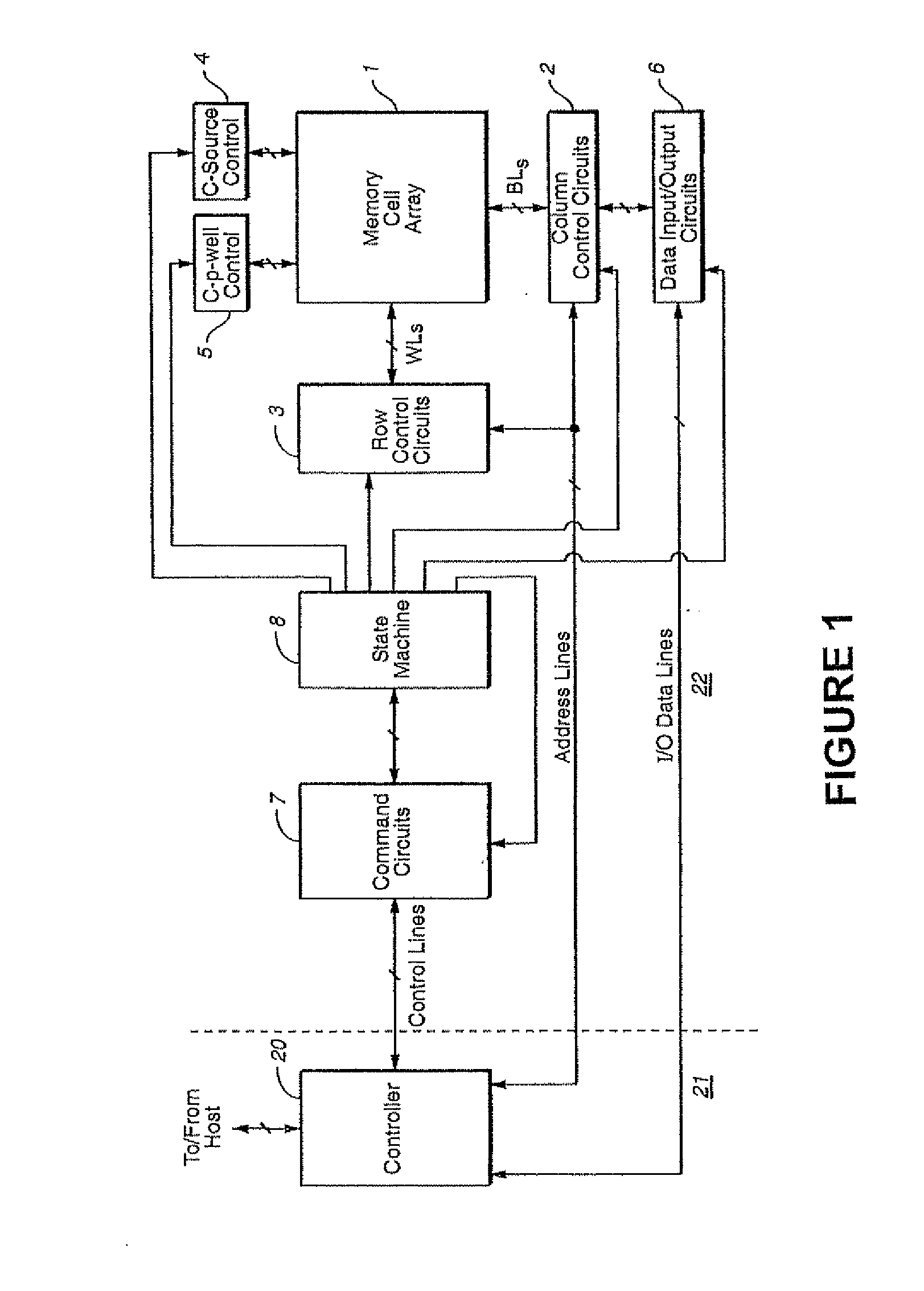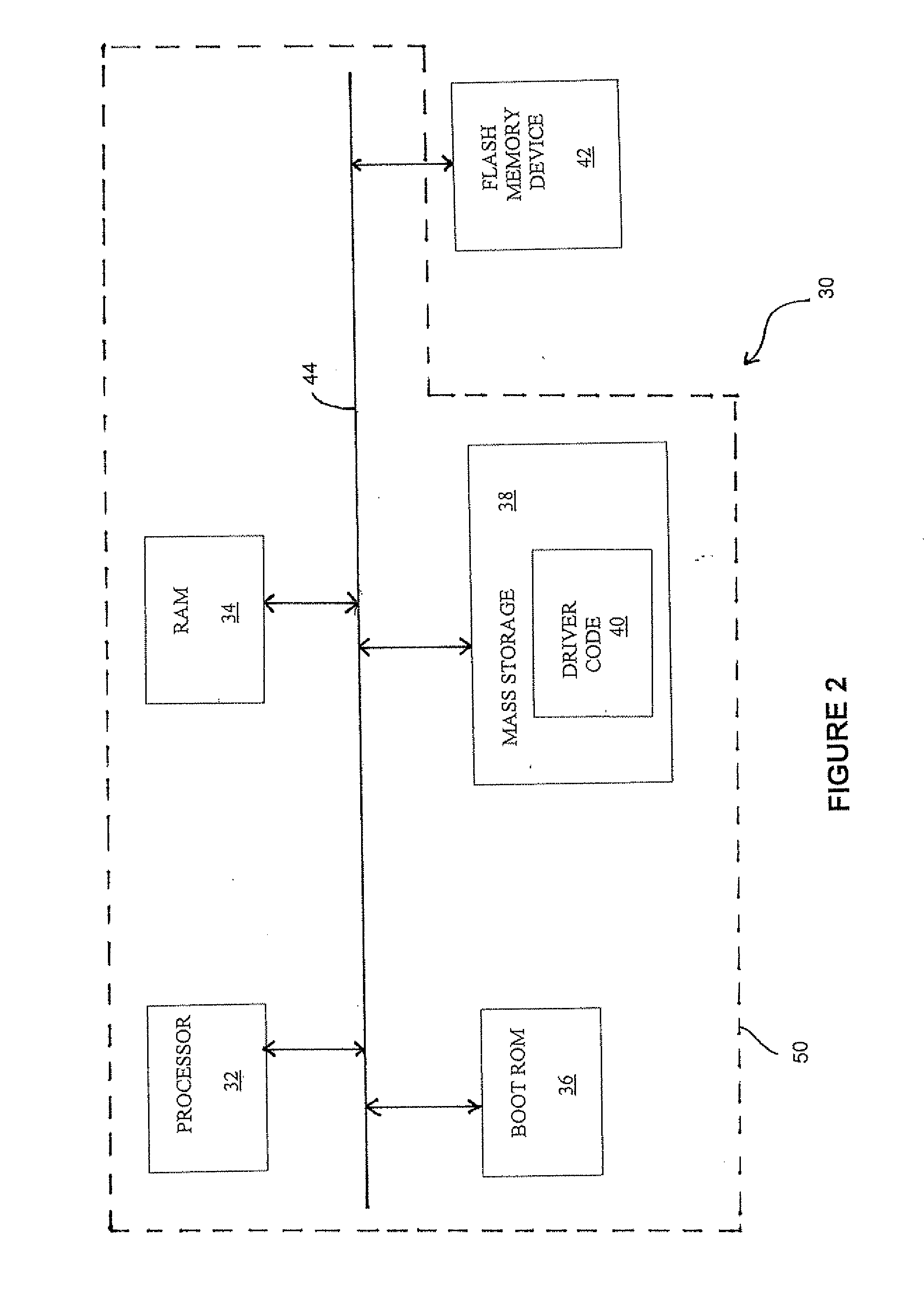[0009]U.S. Pat. No. 6,781,877 to Cernea et al., that is included by reference for all purposes as if fully set forth herein, discusses a disturbance in programming flash memory cells that results from capacitive
coupling between cells. Flash blocks (a block is the smallest chunk for erasing cells in a single operation) are written in units of pages, where a page is the smallest chunk for writing cells in a single operation from the user point of view (and a block contains multiple pages). Typically, the cells associated with a page share a
common word line in the array of flash cells, that word line being connected to the control gates of all those cells. In SLC-type flash memories, each cell stores one bit, and the cells of a page are associated exclusively with that page and with no other page. In MLC-type flash memories, each cell stores multiple bits. In most NAND-type flash devices currently in use the different bits of a cell are associated with different user pages (a “user page” is the chunk of data provided by the user of the flash device in a single programming command, and is herein also called a “logical page”. In contrast, the combination of all user pages stored in the same cells is herein called a “physical page”. A typical user page is currently of a size of 2K bytes, and therefore a corresponding 4-bits-per-cell device has a physical page size of 8 Kbytes. The above sizes ignore some amount of extra cells provided for each page for management purposes, and therefore are only approximations), but there also are MLC devices in which all bits of a multi-
bit cell are associated with the same user page. The present invention is applicable to both types of MLC devices. The present invention is also applicable to SLC devices, even though it is most useful for MLC devices that store more than two bits per cell: three bits per cell or four bits per cell or even a higher number of bits per cell. This is because the
advantage of the present invention is in increasing the accuracy of programming operations, and such accuracy is most useful when the margin between the threshold voltages of flash cells programmed to different states (to represent different values of stored data) is relatively small, as is the case in MLC devices storing many bits per cell.
[0010]In the explanations below we assume that the flash device is of the first MLC type mentioned above. We also assume that a word line corresponds to a single physical page that contains a number of cells that is equal to the number of bits in a logical page. Therefore the word line corresponds to a number of user pages equal to the number of bits per cell in the device. There are flash devices where this is not so and a word line contains multiple (most commonly two) physical pages, each physical page corresponding to multiple user pages. The use of the single-physical-page-per-word line case in the explanations is done only for the sake of simplicity, and the present invention is equally applicable to the multiple-physical-pages-per-word line case.
[0011]Flash blocks are typically programmed in sequential order, from the lowest-numbered word line to the highest-numbered word line. Cernea et al. disclose that there is a capacitive coupling between the cells in different word lines, introducing undesired disturbances into the values of threshold voltages attained by the cells. The effect of such coupling is that when programming a cell in word line number N to a relatively high threshold, the
threshold voltage of adjacent cells in word line (N-1) are increased. This mainly applies to the cell in word line (N-1) that is directly “below” the currently programmed cell, but is also applicable to a lesser extent to other nearby cells in word line (N-1). See FIG. 2 of Cernea et al. that shows an example of capacitive coupling from a given cell affecting three cells in the word line below the cell.
[0012]As the programming of word line N occurs after the programming of word line (N-1), the cells of word line (N-1) remain with a
threshold voltage that is higher than intended, possibly causing errors when reading the data. When a block of flash cells is programmed sequentially from first word line to last word line, the capacitive
coupling effect introduces errors into cells of successive wordlins programming the second word line introduces errors into the first word line, programming the third word line introduces errors into the second word line, and so on until programming the last word line introduces errors into the next-to-last word line. The only word line not suffering from the capacitive
coupling effect is the last word line, as no other word line of the block is programmed after the last word line.
[0013]Even though Cernea et al. discuss only the coupling from a word line to its immediate predecessor word line, the capacitive
coupling effect is also known to occur across larger distances between word lines, even though to a much lesser extent. That is—the programming of word line N might introduce disturbances into cells of word line (N-2), and even into cells of more distant word lines. The present invention is equally applicable to such longer distance effects, even though for simplicity the explanations are given in terms of the “immediate neighboring word line” case, which is also the most important effect.
[0014]It should be noted that it is not possible to use a counter-measure against capacitive coupling of word lines by programming all cells in all word lines possibly with the exception of cells in the last word line) to threshold voltages that are lower than the desired value by a fixed amount, expecting that when programming the next word line the
capacitive effect will increase the threshold voltages and bring the threshold voltages to the desired value. This method cannot work because the effect of the capacitive coupling is not fixed but is dependent on the value programmed into the disturbing cell. A cell programmed to a state of high threshold
voltage causes a larger disturbance in its neighbors than a cell programmed to a
lower threshold voltage. This
data dependency makes it impossible to use a fixed correction to counter the problem.
 Login to View More
Login to View More  Login to View More
Login to View More 


